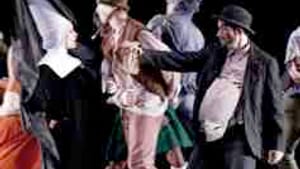Stay in the Loop
BSR publishes on a weekly schedule, with an email newsletter every Wednesday and Thursday morning. There’s no paywall, and subscribing is always free.
Sound and fury, signifying…. what?
Paul Taylor at Annenberg (2nd review)

Paul Taylor is one of the seminal figures in modern dance. He trained at Juilliard and worked with Merce Cunningham's dancers before moving on to Martha Graham. Although he is now 80 years old, he continues to tour his small troupe of 12 dancers all around the U.S.; today he has 133 original dance works in his repertoire, all his.
For all Taylor’s deserved acclaim as one of the pioneers of what we now call modern dance, he’s different from Cunningham or Graham. Taylor has a soft spot for beauty in motion; and while he loved Merce, his work has never been as abstract as Cunningham's, except for a few monumental experimental dances created early in his choreographer-dancer career.
Taylor choreographed works like Duet, in which neither he nor his accompanist moved for the duration of John Cage's Non Score, and Epic, in which Taylor walked back and forth across the stage carrying a briefcase while the telephone time message repeated endlessly. The latter earned a famous review from Louis Horst in Dance Observer with four inches of blank space and the initials “L.H.” at the bottom.
Not for Taylor all of Martha's high drama of Greek legends. For most of his long career Taylor has created dances in which humans move like divine creatures to some of the greatest music ever written.
Special kind of ballet
During his recent Annenberg run, we saw more of the mature Taylor— a man who savors movement and music, with an endless ability to weave these elements together into theater— than we did of the briefcase and the telephone message. Two of the offerings, Arden Court and Cloven Kingdom, both rich works from the 1970s and ’80s, looked much like ballet, albeit a very experimental ballet.
But the program’s showpiece was something altogether new called Phantasmagoria. At an age when most people are counting their retirement funds, Taylor pulled off an altogether new dance piece, but one a world away from Arden Court and Cloven Kingdom. It was so far away from the beautiful leaps of Arden, and the whimsical men in tuxedos prancing around like ponies in Cloven, that you had to wonder if Taylor was simply having fun or whether he'd been holding back all this nonsense for years. Phantasmagoria is something close to vaudeville, with one act quickly replacing the other and no real connection.
Taylor's inspiration is Pieter Brueghel's famous painting, Wedding Dance in the Open Air. If you’re interested in art history, the opening section with dancers wearing costumes is absolutely perfect in every detail to the 17th-Century masterpiece that Taylor claims as his source. The ladies’ aprons and vests, the sturdy (not silky) fabric, and the gentlemen's breeches and puffy sleeved shirts seem to have been lifted in whole part from the famous painting. The dancers frolic on stage to the sound of anonymous Renaissance composers.
Adam and Eve meet the Isadorables
This is all well and good, but quickly our dancing peasants are joined by an East Indian Adam and Eve who engage in some naughty playtime with a big snake. A Byzantine nun wanders through, shaking her finger in the duo's direction. Then, voila! We have an Irish step dancer, an excellent young African-American woman Michelle Fleet, whose last name describes her own skills. Quickly following on this come the Isadorables, a trio of young ladies wearing Grecian style robes and dancing barefoot in the manner of the early dance experimenter Isadora Duncan. A drunken Bowery Bum stumbles on stage, his booze in a paper bag. He staggers around the Isadorables and, just as you’re getting accustomed to this scenario, figures in clingy gray robes appear to point their fingers at the dancers, who drop down immediately: It’s that famous St. Vitus Dance that brings them down. Meanwhile the Byzantine nun wanders through all of this.
And that’s it. No real beginning, no real end, and utter confusion about what this conglomeration of movement and ideas means, or if it means anything at all. One observer said it was like stream of consciousness, or maybe you'd had too much to drink or smoke.
Was Taylor just having fun? Who knows? Was Taylor serious about this conglomeration? I doubt it. Was it worth seeing? Sort of. But maybe the best person to respond to that question was the little girl dancing gleefully in the Annenberg lobby during intermission, mimicking the peasant dance.♦
To read another review by Judy Weightman, click here.
What, When, Where
Sign up for our newsletter
All of the week's new articles, all in one place. Sign up for the free weekly BSR newsletters, and don't miss a conversation.
